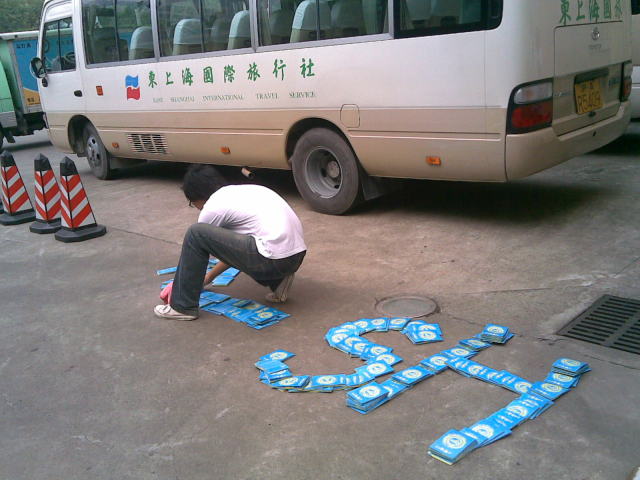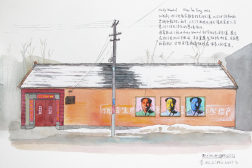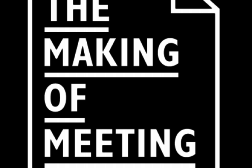



Shanghai Detour
The art ride detour includes a free mini-van ride + a Shanghai art map for its most distinguished guests!
Time: September 10th to the 12th, from noon to 7:00 pm
The detour runs every 30 minutes to and from ShContemporary
What do I get? In a Nutshell: Access to more than 30 galleries, museums and independent art spaces in Shanghai through 3 individually customized shuttle rides.
Lines include:
Line 1 at People’s Square (MoCa + Biennale sites)
Line 2 at 50 Moganshan
Line 3 on The Bund
Line 3 at Duolun Lu Cultural District
Line 3 in Pudong and more!
Where do I find it? Watch out for art maps, docents and signs with the Shanghai Detour logo during the course of ShContemporary. You can also ask your gallery or Shanghai art friends about this service.
More about Shanghai Detour:
Shanghai Detour is a collaborative project in the form of a shuttle ride and art map for the distinguished guests of Shanghai, bringing together all the disconnected parties of Shanghai art scene, including museums, commercial galleries, and independent art spaces–an initiative undertaken for the first time. Thanks to the active participation of all the joined parties, this project is designed to show its guests a vibrant image of Shanghai and promises to be the first step for a more long-term vision of sharing and spreading information in our local art community. We hope that this simple tool will give our distinguished guests–both a national and international–useful source of information to guide their exploration of the city and to discover unexpected artistic and creative niches in Shanghai.
Shanghai Detour is a non-for-profit initiative jumpstarted by Arthub Foundation early this year, which invited the scene makers of Shanghai to consecutive informal roundtable sessions to co-ordinate the parallel Biennial and Shcontemporary activities. Organized with the support of IFA and Alexis Kouzmine, Lime Design and BizArt. With special thanks to Shangart, David Chan of SGA and Contrasts gallery.
Watch out for signs with the Shanghai Detour logo during the course of the ShContemporary Fair and Shanghai Biennial opening week for free bus rides between the fair, the biennial site and venues at 50 Moganshan, The Bund, Wujiaochang and additional areas.
Participants:
1918 Art Space
Andrew James Art
Arthub
Art Labor
Art + Shanghai
Aura Gallery
BizArt
Contrasts Gallery
East Asia Contemporary
Eastlink Gallery
Ifa Gallery
Island6 Art Center
James Cohan
Ke Center
M97 Gallery
MoCA
Osage Gallery
Oriental Vista Gallery
Park Ryu Sook Gallery
Shanghai Gallery of Art
Shanghart
Shine Art Space
Stir Art Gallery
Studio Rouge
Wujiaochang
Zendai Museum
Background on Shanghai Contemporary Art
The history of Chinese contemporary art might be a matter of a couple of decades, but is rooted in a progressive albeit uneven correspondence with the West. In Shanghai, in particular, the art scene’s development has been characterized by very peculiar social, cultural and economic circumstances.
In the early 1980’s, Shanghainese artists such as Li Shan, Yu Youhan, Chen Zhen, Zhang Jianjun, Yang Hui, Song Haidong and Ding Yi established their reputation by opposing Soviet-style social realism and looking for ways in which Chinese art could be synched with that in the West. In the mid-80’s, some other local artists joined in, and continued to discuss the role of contemporary art in modern society, its relationship to the past and so-called ‘old culture.’ These were informally organized groups of intellectuals, who were looking into articulating their own position in the more tolerant cultural climate of Deng’s China. They were not only active in the cultural sphere as artists, but also as high school and university teachers, and continued their pursuits until the early 1990’s by exploring Western modernity, philosophy, literature and traditional Chinese philosophy as well as challenging traditional forms of art-making.
Following the No U-Turn/China/Avante-Garde exhibition organized in Beijing (1989), with the participation of artists’ collectives from around the country, featuring diverse media including performance, installation, Political Pop art, and experimental wash and ink, Shanghai artists responded with private happenings and exhibitions, using temporary spaces or casual venues. These events barely had a wide public outreach, but provided platform for self-expression. In the meantime, almost all artists were invited to take part in annual, officially sanctioned exhibitions, and occasionally, they also exhibited in more international contexts, first in Asia, and eventually in the US and Europe.
Although major international showcases of contemporary Chinese art such as in Berlin, Paris and Venice has attracted much attention since then, the situation in Shanghai did not change until 1996 and 97′. Finally, Lorenz Helbling, a Swiss gallerist, started organizing exhibitions of avant-garde artists in Shanghai, first in his house and eventually at his gallery space in Fuxing Park. Shanghart was thus the first private gallery devoted entirely to the promotion of so-called ‘avant-garde art,’ which included Political Pop, Abstract Painting, and Kitsch art. Following his efforts, numerous other galleries flourished. Nowadays we can count more than 50 of them, most of which can be found on this map.
Meanwhile, a new and active generation of visual artists have emerged around BizArt Art Center, a not-for-profit reality of Shanghai which nurtured many of the critical artists in Shanghai in the past decade. Its artistic Directors Xu Zhen and Yang Zhenzhong, together with a variable group of young artists, created some of the most poignant exhibitions and happenings of the last 10 years. With their curatorial kick-off Art for Sale in 1999, which took place in a shopping mall on Huaihai Road, this group continues to work in the spirit of experimentation: all their exhibitions from Fang Mingzhen and Fang Mingzhu, organized as a satellite exhibition for Shanghai Biennale in 2002, to the Dial 62761232 exhibition, displayed new forms of curatorial approaches. The most critical outcome was possibly their last exhibition in 2006 called Solo Exhibition, a “hidden” group show of 38 artists, but presented and communicated as individual solo exhibitions. Each artist had a space for a solo presentation as a critical response to the mass presentations like Biennials and Art Fairs worldwide.
Needless to say, there was also an earlier yet similar response to the almost “internationalized” state of Shanghai art scene, thus the FUCK OFF exhibition, organized by Stars Group member Ai Weiwei, together with the critic Feng Boyi, took place in Shanghai in response to the 2000 Shanghai Biennial at Eastlink. From the early 2000’s on, artists and galleries connected in creative clusters, the most famous being M50. Nowadays, there are also groupings of galleries at the Bund, French Concession, Wujiaochang, Duolun Lu, Taicang Lu and further along the Suzhou Creek.
On the institutional front, the Shanghai Art Museum for many years served as the only museum platform for the presentation of contemporary art. The museum-backed Shanghai Biennial was founded in 1996 and became internationalized in 2000, at a time when video art and installations were first allowed on the premises of the Museum. In recent years a number of art museums have rapidly increased in Shanghai, both of a public and private nature. At the end of 2003, Duolun MoMA opened, the first government-funded platform of its kind in Shanghai, and in 2005 two private institutions opened Zendai MoMA and Shanghai MoCA. The opening of these museums brought optimism to the art scene here.
Finally, Shanghai, with its international and futuristic promise, had an opportunity to become a competitive platform for the arts: still many questions remain on the role of these organizations, their programmatic coordinates, their mission and visions, and means of financial sustainability. These issues are too complicated to be detailed here. All of the above-mentioned platforms, those on the map as well as new facilities at various universities continue to explore these issues, with the goal of making this city a distinctive destination where new art is made, presented and discussed.
We believe that Shanghai Detour is representative of what Shanghai is today and who we are, all of us or at least all of the people who think that sharing is the most valuable way to demonstrate trust in the future of the arts in Shanghai.
— Jointly penned by Arthub’s Davide Quadrio and Defne Ayas, and independent curator Biljana Ciric



